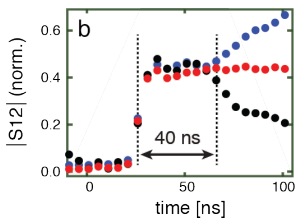Phonons radiated by artificial atoms
Science news with bad titles usually attract a lot of attention. A recent example is “The sound of an atom has been captured” 1]. Laypeople must know that atoms do not emit sound. Quantum acoustics study the propagation and the interaction of phonons, the analogues in sound to photons in light. An atom cannot emit phonons, but an artificial atom (a quantum dot or a superconducting qubit) can. Martin V. Gustafsson (Chalmers University of Technology, Göteborg, Sweden) and colleagues 2 have studied the free propagation of quantum information by phonons (specifically surface acoustic waves) strongly coupled to a superconducting qubit. In their experiments, phonons have a role similar to that of photons in quantum optics. A beautiful result in quantum acoustics that deserves our attention.

Surface Acoustic Waves (SAWs), also referred to as Rayleigh waves, where theoretically predicted in 1885 by Lord Rayleigh 3. He showed that an elastic medium can support surface vibration modes that are wavelike. They are surface waves because their amplitudes decay exponentially with increasing distance into the solid from the surface and their energy is peaked within a depth of approximately one wavelength 4. By using piezoelectric materials the electric energy in electronic circuits can be transduced to mechanical energy in the form of SAWs. The so-called InterDigital Transducers (IDTs) are capable of converting acoustic waves to electrical signals and vice versa. Today, SAW devices are extensively used in commercial mobile phones instead of the traditional quartz crystals (based on bulk waves) because they can operate at higher frequency.
From the quantum point of view, SAWs are made of phonons so they can be coupled to an artificial atom (a qubit) via piezoelectricity (see Fig. 1 for a circuit model). Thanks to SAWs a bidirectional communication with the qubit can be achieved. The great advantage is the low speed of sound, which allows the observation of the emission of phonons from the qubit in the time domain, i.e., to listen the sound of the artificial atom.

The artificial atom (see Fig. 2, right micrographs) is a superconducting qubit of the transmon type. A transmon consists of a Superconducting Quantum Interference Device (SQUID) shunted by a large geometric capacitance so the Josephson inductance forms a resonant circuit. This nonlinear inductance gives rise to the anharmonic energy spectrum characteristic for an (artificial) atom, i.e., a set of discrete energy levels. The transmon is well suited for coupling to SAWs since the shunt capacitance (about 85 fF in Ref. [2]) can be designed to strongly couple to the IDT thanks to their common finger structure (see Fig. 2 and compare left and right micrographs). The transitions between the energy levels of the qubit results in the emission of SAW phonons and, conversely, a SAW beam can excite energy level transitions in the artificial atom.

A careful reader may wonder how the authors have verified that the quantum information between the qubit and the IDT is propagated by phonons instead of photons (in fact, the IDT is controlled by using microwave pulses). To solve this question, Gustafsson and colleagues [2] take advantage of the slow propagation of SAWs. After the excitation of the qubit to a high-energy level, its state decays emitting a signal than can be read by the IDT. Figure 3 illustrates that this signal takes about 40 ns to travel the distance of about 0.1 mm separating the IDT and the qubit (i.e., the speed of the signal is about 2500 m/s). Hence the signal is phononic. Another check developed by the authors is a careful comparison between the measurement of the signal, by using two-tone spectroscopy, and the numerical predictions of a theoretical model of the system.
From the point of view of future applications, SAW phonons have several striking features with respect to photons. Their slow speed of propagation allows that the qubits be tuned much faster than SAWs traverse inter-qubit distances on a chip; this property enables new dynamic schemes for processing quanta. Additionally, the SAW phonons wavelength at a given frequency is shorter than the size of the qubit (since it depends on sound speed instead of light speed), so new techniques for trapping quanta into cavities can be developed. In my opinion, the future for this technology in quantum information processing is bright.
In summary, the propagation of quantum information using quantum acoustics has been demonstrated by using SAW phonons. This achievement provides new tools for quantum information processing in regimes difficult (or even impossible) to reach using photons.
References
- “The sound of an atom has been captured” Phys.Org, Sep 11, 2014. ↩
- Gustafsson M.V., A. F. Kockum, M. K. Ekstrom, G. Johansson & P. Delsing (2014). Propagating phonons coupled to an artificial atom, Science, DOI: http://dx.doi.org/10.1126/science.1257219 ↩
- Lord Rayleigh, “On Waves Propagated along the Plane Surface of an Elastic Solid,” Proc. London Math. Soc. 4–11 (1885). DOI: 10.1112/plms/s1-17.1.4 ↩
- A. A. Maradudin, G. I. Stegeman, “Surface Acoustic Waves,” in Surface Phonons, edited by W. Kress, F. W. de Wette, Springer, 1991, pp 5–35. DOI: 10.1007/978-3-642-75785-3_2 ↩
5 comments
[…] el tema, puedes leer mi post (en inglés) “Phonons radiated by artificial atoms,” Mapping Ignorance, 22 Sep 2014. El artículo técnico descrito es M. V. Gustafsson, A. F. Kockum, M. K. Ekstrom, G. […]
I’m confused because I always thought that the definition of a qubit cannot be associated to a physical thing. What really means an “artificial atom”?
Superconducting circuits are really artificial atoms because their resonance frequencies resembles those in atoms.
[…] Atomo baten soinua entzun dela iragartzen zuen berriak izan duen oihartzunaren aurrean, Francisco R. Villatoro atomo artifizial bat zer den azaltzera etorri zaigu. Eta, entzundako doinu hori fonoiez osatuta dagoela: Phonons radiated by artificial atoms. […]
[…] Ante la noticia que tuvo bastante eco de que se había escuchado el sonido de un átomo, Francisco R. Villatoro sale al paso y explica qué es realmente un átomo artificial y que ese sonido está constituido realmente por […]